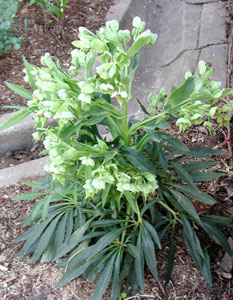Resource Library
Plant of the Week: Stinking Hellebore
The University of Arkansas System Division of Agriculture does not promote, support or recommend plants featured in "Plant of the Week." Please consult your local Extension office for plants suitable for your region.
Plant of the Week
Stinking Hellebore
Latin: Helleborus foetidus

The hellebores are awakening in my garden. These tough, evergreen perennials are favorites because they have bright green foliage throughout the drab days of winter and they start the blooming season off as winter comes to an end. The so-called stinking hellebore (Helleborus foetidus) is the first to bloom in my garden, usually beginning around the end of January.
About 20 species of hellebores are known, with most coming from southwestern and central Europe, the Mediterranean region and eastward to Turkey and central Asia. They belong to the buttercup family and nearly all make good garden plants,though only four or five species and their hybrids are commonly offered in nurseries. The genus is divided into two major groups: the stemless species – acualescent -- that produce leaves from the ground, and those that flower and produce leaves on an above ground stem -- caulescent. The stinking hellebore is the most commonly grown of the caulescent species.
Helleborus foetidus is widely distributed throughout southern and central Europe and Asia Minor where it typically grows in mountainous regions in heavy shade. It has an upright habit of growth with plants reaching 2 feet when in bloom. The finger-sized stems are thick and succulent and produce deep green compound leaves to 8 inches across with five to seven leaflets. There is occasional basal branching of plants but typically the central stem produces the most blooms. Contrary to what the common name implies, the plant doesn’t really stink instead is malodorous only if the leaves are crushed.
Fifty to 75 flowers are produced from the terminal bud on the plant over about a six-week period in late winter. Blooms are chartreuse in color and sometimes rimmed with a thin picotee of maroon. Individual flowers are .75- inch across with five showy sepals, as is typical for members of this family.
The true petals are transformed into nectary glands which are in a whorl just outside the many stamens produced in the center of the blossom. Following flowering, a whorl of five pod-shaped follicles are produced inside the whorl of sepals. Stems die to the ground after the seeds mature and emerge anew in the fall. All parts of the plant are considered poisonous.
Wintertime bloomers such as this species often grow in dense shade so pollination can be a problem. Recent research from Spain has demonstrated that yeast cells invade the nectary glands of stinking hellebore and, as the sucrose is metabolized to alcohol during fermentation, heat is produced. Air temperature inside the flowers increased 4 to 8 degrees Fahrenheit over outside temperatures. Ecologists call this kind of response “mutualism” where the plant, the yeast and the pollinating bumblebees all benefit.
The plant benefits from improved pollen germination, faster pollen tube growth and better fruit set during cold weather. The yeast earns its living converting sugars to alcohol while the bumble bee benefits by having a warm respite as it makes its way from flower to flower on a cold winter day. Also, just possibly, the bumble bee may enjoy a little home brew before it heads back to the hive.
The caulescent hellebores are not as popular in gardens as the stemless species, partly because individual plants tend to live only four or five years before dying. However, because they reseed regularly, plants in various stages of development are usually present. Plants bloom the second year from germination. Additionally, caulescent hellebores cannot be divided as is often done with the longer lived stemless species.
Stinking hellebore is hardy from zone 5 through 8. It is adaptable to a wide assortment of conditions but should have good wintertime drainage. It is best in partial or full shade. It can be used as a massed groundcover or allowed to randomly move about the shade garden. Year-old seedlings move more easily than older blooming plants.
By: Gerald Klingaman, retired
Retired Extension Horticulturist - Ornamentals
Extension News - February 1, 2013
The University of Arkansas System Division of Agriculture does not maintain lists of retail outlets where these plants can be purchased. Please check your local nursery or other retail outlets to ask about the availability of these plants for your growing area.